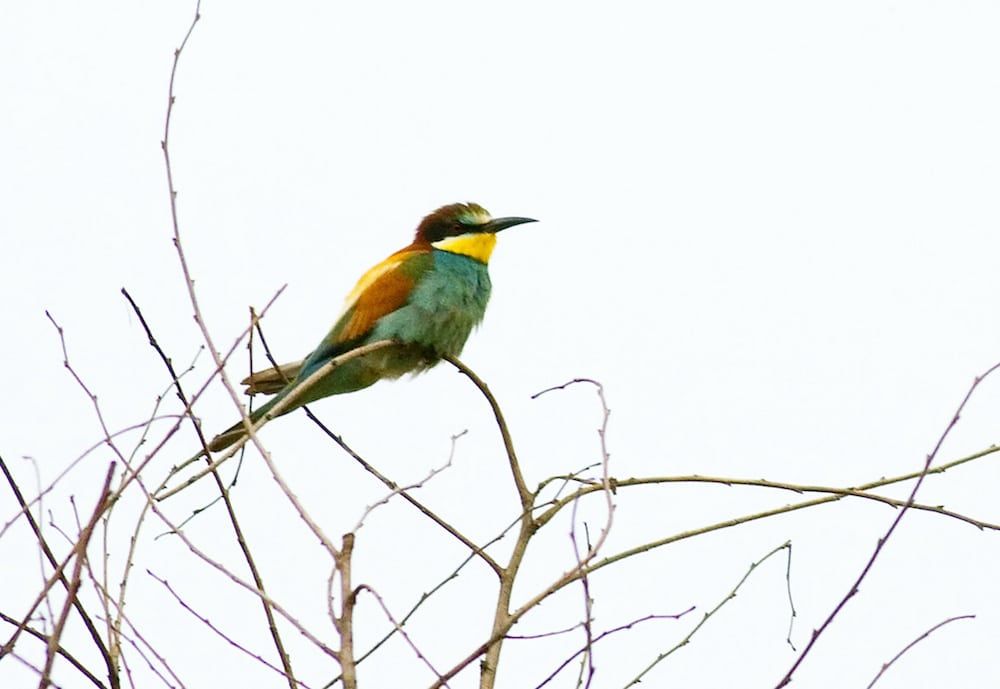
The Bee-Eaters at the Cemex quarry, in East Leake, Nottinghamshire. See NTI story NTIBIRD. Thousands of twitchers flocked to a village quarry to try and get a glimpse of a rare bird that hadn’t been seen for almost 50 years. Bird watchers came out in their numbers when they descended on the site in order to get a sighting of the European bee-eater. The yellow, blue and brown beauty is more often found in southern Europe and North Africa, and the last time one was spotted in Nottinghamshire was back in 1970. But a total of seven birds have been spotted at the Cemex quarry on Lings Farm in East Leake, Notts., with the first being seen on Sunday (25/6). The sighting got the bird watching community all in a flutter and prompted up to 1000 enthusiasts in the week to make their way to the site. European bee-eaters have only been known to nest six times in Britain since 1920, but are becoming more common in recent years due to climate change.
Thousands of twitchers have flocked to a remote quarry on the edge of a village to try and get a glimpse of a bird rarely spotted in the UK.
Bird watchers came out in their numbers when they descended on the site in order to get a sighting of the European bee-eater.
The yellow, blue and brown beauty is more often found in southern Europe and North Africa, and the last time one was spotted in Nottinghamshire was back in 1970.
But a total of seven birds have been spotted at the Cemex quarry on Lings Farm in East Leake, Notts., with the first being seen last Sunday (25/6).
The sighting got the bird watching community all in a flutter and prompted around 2,500 enthusiasts to make their way to the site.
European bee-eaters have only been known to nest six times in Britain since 1920, but are becoming more common in recent years due to climate change.
The bird was last spotted in the UK in 2015 and intentional or reckless disturbance of a bee-eater nest is a criminal offence in the UK.
Tim Sexton, from Nottinghamshire Wildlife Trust, said: “As the name suggests they feed mostly on bees however they have also been seen eating dragonflies, butterflies and moths at East Leake.
“Throughout Monday the birds were regularly seen mating and passing food to each other – a strong indication that they are looking to breed.
“The habitat within the quarry should provide all they need in terms of nesting opportunities.
“There is an active sand martin colony on site and the birds have been seen going to roost with the sand martins each evening.
“We are not yet sure how many pairs are present, however, should they stay to breed then they could be here until mid to end of August.
“In the last 50 years, there has been just a handful of breeding attempts by this species in the UK and this would be the first for Nottinghamshire.”
The Royal Society for the Protection of Birds (RSPB) says it is likely the birds will nest in the area, and has deployed volunteers to protect them.
Mark Thomas, from the RSPB, said: “We are delighted to confirm that seven bee-eaters are currently making themselves at home in East Leake, Nottinghamshire.
“The birds have been seen mating, so it’s likely they will nest here.
“Bee-eater sightings have been on the increase: pushed northwards by climate change, these exotic birds will likely become established visitors to our shores, and thanks to partnerships like this one with Cemex we can provide the right habitats to accommodate them.”
Dr Rob Lambert, vice-president of Nottinghamshire Wildlife Trust, added: “The presence of seven bee-eaters at East Leake Quarry in Nottinghamshire is a colourful ornithological tribute to an existing dynamic partnership between Nottinghamshire Wildlife Trust and the quarry operators CEMEX that has been developed for over 20 years at the site.
“Sensitive conservation advice working alongside industry has created here not only suitable wetland and sandbank habitats for a thriving sand martin colony, but now serendipitous homes for new Southern European neighbours bringing vibrancy and excitement to an industrial landscape that will in time, once extraction is complete, pass over into full management of the Trust as a local nature reserve.
“It is a lovely public example of what the Wildlife Trusts do best, local partnerships, local places, benefitting birds and people.”